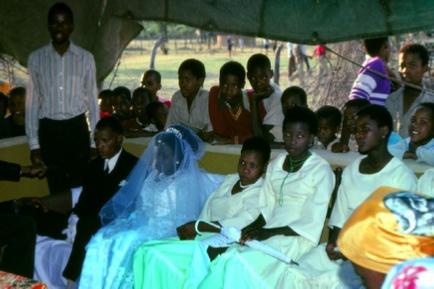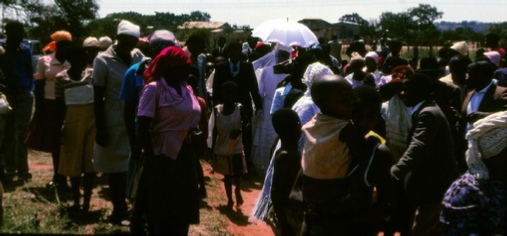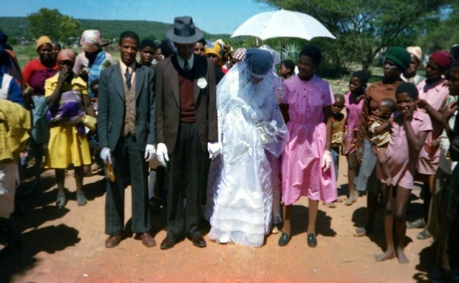© 2018 Dr Margaret Sheppard
The Sekgoa (English) Wedding
This type of wedding, the Sekgoa (English Wedding) is becoming increasingly common. It contains all the parts of the Setswana wedding but has some additional ones.
One of the most striking differences between this type and the Setswana wedding is the bridal clothes -
Although forms of dress may have changed, they are only modifications of traditional kinship obligations, such as the bride's "change" outfits . The same relatives are invited and expected to be present for the same reasons. All marriages are protected against sorcery. Married and unmarried alike play their customary roles. Marriages are still occasions with much feasting and enjoyment and not a time to economize. They always involve the slaughtering of beasts and this "spilling of blood" is the crucial part that, although it may not be stated openly, attracts the Ancestors (Badimo) to enjoy the company gathered together. As Setiloane writes: "Badimo ba rata modumo." -
On these occasions many people are served with food, for example the wedding choirs, (who always increase greatly when the time comes for them to be served!!). This is also believed to please the Ancestors, especially when poorer people are given food as, when people are satisfied by food, the goodwill they feel towards those holding the wedding is believed to attract the Ancestors to continue to help their descendants.
One tradition should perhaps be mentioned. Throughout the wedding the bride is not supposed to eat sweets. If she does, this is believed to bring rain during the marriage, which is obviously very inconvenient, especially as she is supposed to be outside displaying her various outfits. So if rain spoils a marriage, people say it is because the bride has eaten sweets!
The bride usually arrives back at her own home before 11.00 a.m. Some time later, usually about midday, the groom's party arrive at her home. When they are seen to be near by the bride is taken in procession by her bridesmaids and attendants and other relatives. Her head bridesmaid holds the white umbrella over her, and she walks on the arm of one of her male relatives. The groom's party forms a similar procession. He is similarly shaded with his umbrella held by one of the bridesmaids from his side of the family. He is led by a young female relative. Both processions sing traditional songs as they walk -
At one such procession in which I took part the choir was singing in Setswana the following well-
"That flower of the Germans looks like a star, our daughter is wearing a star."
"This child is like a coloured" (i.e. she is very beautiful -
"A Baboon is the one that jumps into a tree, we want cattle."
"An ox wagon of the one who's getting married. A person who's
getting married is taking a lead."
As the bride and groom meet they both come forward from their processions and kiss. and then the groom takes the bride's arm. Both processions then combine and return to the bride's home, still singing the above songs. As they approach the bride's Kgotla they sing:-
"Knock, Knock, Knock~ We are arriving with a married couple."
The older women come out to ululate loudly as a welcome. Spectators rush to witness the arrival.
Another main difference between Setswana Weddings and the Sekgoa Weddings is noticed on the Wedding Feast Days. Goats and sheep are usually slaughtered for the feasts at Setswana Weddings, but at a Sekgoa Wedding a cow is slaughtered. In addition following the signing at the District Commissioner's or church the bride will wear rings like English brides. She will be given one ring like an English "engagement" ring and another like an ordinary wedding ring. These will both be put on at the same time as engagements are usually secret because of the fear of Sorcery, so an engaged woman does not advertise the fact with an engagement ring. Brides married with a Setswana wedding do not wear rings. Also at this type of wedding the bride is always married in a white wedding dress with a veil, and usually has bridesmaids in "English-
As the bridal parties return to their respective dikgotla or bases from the church or the District Commissioner's office they may travel by car. As the cars drive into the Kgotla they will hoot loudly in a way that is always understood to be an announcement of the arrival of a wedding party. After the cars have driven round the Kgotla a few times, hooting, the bride or groom are helped out by their attendants and enter their home before continuing with the next stage of the wedding.
This type of wedding is first registered at the Chief's Kgotla, then at the District Commissioner's and, if it is to involve a church service, also at the church at which at least one of the couple must be a member. The wedding usually takes place on two successive week-
The programme for a specific wedding illustrates a typical format for this type of Sekgoa wedding:
The couple had been engaged for some years. The groom worked in the mines in South Africa and had never had any formal schooling but had learnt to read and write in the mines. He had paid for the education of his fiancee, who had passed Junior Certificate (an exam taken at the end of 3 years of Secondary School) and she had been working for the past three years as an unqualified Primary Teacher.
He returned from the mines for his marriage on July 13th. The walls had already been built and decorated around the houses at his family's home by his female relatives. Also that year he had sent money for builders to build his two-
On July 17th relatives collected in the morning in their best clothes to go and register the marriage at the District Commissioner's, and on the 21st July they gathered again to go and register the marriage at the church. The groom then returned to the mines.
On August 9th he returned from the mines. His female relatives left without him to "go and ask for a wife". On the next day, August 10th, the groom and the male relatives left for the presentation of Bogadi, and his "choir" left on the back of a tractor.
Then on August 11th the wedding feast was held at the bride's home; during the morning they were married at the District Commissioner's, and then at the Church. After lunch the respective wedding choirs “competed” against each other.
On August 12th the groom and his relatives returned to Kanye. The following weekend, August 18th, the wedding and feast was held at the groom's. On August 19th the bride was brought with all her possessions and on August 20th she was shown her house.
As The groom was from Kanye and the bride from a sub-
At this type of wedding the bride wears white and is married with rings, there are bridesmaids and there is a wedding cake
The bride arriving. She sits in the front with her male attendant and the bridesmaids and other attendants on the back. When they arrive at her kgotla the cars drive around the kgotla hooting loudly to announce the wedding.
The couple then enter the lolwapa and are led with their bridesmaids and attendants to an area that has been specially prepared for the marriage. It usually consists of a little decorated square or oblong walled area, sheltered from the sun (and sometimes rain) by a tarpaulin. The seats where the couple will sit are often covered with white material. They sit here looking very solemn (as they did whilst in their processions). The bride has her hand in that of the groom's. The bridesmaids arrange the bride's dress and veil and sit at*her side, and the groom's best man and attendants arrange him and brush the dust off his suit as he is sitting.
Various close older relatives of both of the couple will sit in this enclosure, the men sit on chairs and the women often sit on the ground. These relatives include Maternal Uncles and their wives, paternal and maternal aunts and uncles. The wedding cake or cakes (like English ones and often ordered at great expense from South Africa) are commonly on display on a table in front of the couple.
After sitting like this for sometime, there may be prayers and hymns or "mini" choirs may come and sing to them. These latter usually sing religious songs. They will eventually be taken to the bride's mother's house to eat. Here they sit together at a table. and are usually accompanied by special relatives and the bridesmaids and attendants.













The wedding cake or cakes are on display in front of the bridal couple
Relatives of the groom (if at the bride’s home) or bride (if at the groom’s home) sit with them -
The bridal couple entering the lolwapa
They then sit with their bridesmaids and attendants plus important relatives. The visiting family is formally welcomed by the host family Small choirs may well sing to them -
Then the bride and groom with their attendants go to the mother’s house to eat.
They are served by relatives of the bride or groom who have been specially chosen to do so. The usual wedding food is served -
Meanwhile other relatives are served in the shelter outside, or special visitors may be called into one of the other houses to eat at a table. Other "lesser" people may be served with meat and samp (boiled maize seeds) or sorghum porridge. Sometimes the wedding cake may be cut by the bridal couple, otherwise it is cut up and served out by the servers.








The bridal procession then process into the groom’s kgotla. She is led by a male relative and the bridesmaids and other relatives follow. The groom’s procession is similar with the groom being led by a female relative. The bride is sheltered by a white umbrella held by the Chief bridesmaid and the groom by a coloured umbrella held by one of the bridesmaids form his family
The accompanying relatives from each side are singing traditional wedding choir songs and onlookers press close to see the bride
When the two processions meet, the bride is handed to the groom and they kiss. The choirs combine and the procession usually processes around the kgotla singing the wedding songs (see above)
The procession with the bride and groom is then led into the bridal household
The format of these weddings held at the respective homes is identical. These following photos illustrate this. Some are of a bride arriving for the part at the groom’s home and others from weddings held at the bride’s home.
Spectators crowd around to catch sight of the bride. N.B. she is supposed to look down and to look sad to be leaving her own home.



